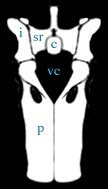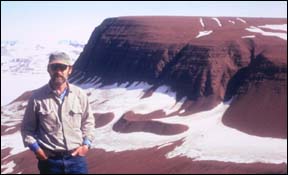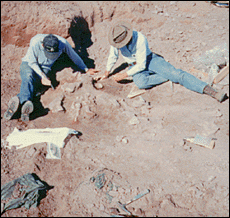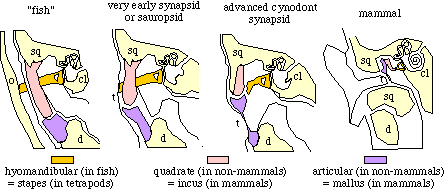
BACK TO DINOSAURS 2000 HOME PAGE
Triassic in Europe is the type area for that system.
As previously mentioned, the Triassic is named for three divisions in Germany - the Bunter (mostly Early Triassic age), the Muschelkalk (Middle Triassic in age), and the Keuper (mostly Late Triassic in age).
The basins that contain the Keuper formed in part of the Atlantic rift system, where it extends into Europe.
The Keuper in particular has produced a rich assemblage of archosaurs and dinosaurs, along with other important vertebrates.
Quite a number of members of the Crurotarsi are known from the Keuper, especially phytosaurs, rauisuchians, aetosaurs, and crocodylomorphs.
However, the Keuper is most famous for its dinosaurs, the best known of which is Plateosaurus.

Plateosaurus, based on Galton (1990).

Plateosaurus is a fairly large (about 6-8 m long) dinosaur known from abundant remains. It was first described in 1837 by von Meyer but became well known only after excavations in 1911-1932 at Trössingen, near Tübingen. These excavations uncovered a huge accumulation of articulated, partial to complete skeletons of Plateosaurus.

The skull of Plateosaurus is deeper and more robustly built than that of Coelophysis, and Plateosaurus has smaller, leaf-shaped teeth with coarse serrations. This is the skull of an herbivore (photo by P.M. Galton). The neck is long and the body stocky.
The pelvis of Plateosaurus is unusual because it has a broad, "apron-shaped" pubis. The pelvis is shown on the right, viewed from the front. Abbreviations are: c, sacral vertebral centrum; i, ilium; p, pubis; sr, sacral rib; vc, visceral canal. This pubis provides a strong shelf, plausibly to support the massive gut. A number of authors have argued that this "apron-shaped" pubis is a shared derived character for the Prosauropoda, which includes Plateosaurus and a large number of other Triassic and Early Jurassic age dinosaurs, all basically similar in structure to Plateosaurus.
|
|
1. Perforate Acetabulum |
Plateosaurus is a member of the Sauropodomorpha, the shared derived character for which is a small head with peg-like teeth (3 above). Another character cited as a shared derived one for this group is elongated cervical vertebrae. A more famous representative of the Sauropodomorpha is Brachiosaurus, which is a member of the Sauropoda. The shared derived character for the Sauropoda is having extra cervical vertebrae, which is achieved by shifting the shoulder girdle posteriorly.
Much of the rest of the skeleton of Plateosaurus is rather primitive. The foot, for example, is very similar to Herrerasaurus. It is quite possible, even likely, that the Prosauropoda is actually a paraphyletic group that should be split into smaller monophyletic groups.
Other vertebrate fossils from the Keuper include the oldest well preserved turtles, many large archaic amphibians, and some scraps of early mammals. There are also a number of small to large Coelophysis-like theropods.
On the east coast of Greenland lie spectacular outcrops of red beds called the Fleming Fjord Formation. The Fleming Fjord looks very much like the Keuper, the main difference being that the Keuper is mostly covered by vegetation or culture. Recent expeditions to Greenland led by Farrish Jenkins of Harvard and Neil Shubin of the University of Pennsylvania have uncovered a wealth of vertebrate remains surprisingly similar to what has been found in the Keuper of Germany and the rest of Europe.

The Fleming Fjord Formation, geophysicist Dennis Kent in foreground. Photo by Neil Shubin.

One of the more common types of tetrapods found by the Greenland expedition was Plateosaurus. As in the Keuper, large numbers of individuals were found in individual layers in positions that suggest they became mired in soft mud. On the left is an excavation for one of these Plateosaurus specimens in which the foot can be seen (Photo by Neil Shubin).
The same basic kinds of "amphibians", aetosaurs, turtles, and other sauropsids as seen in the Keuper were found. Two real surprises, however, was an articulated pterosaur similar to Eudimorphodon, and partial jaws of early mammals.
During the Triassic we see a number of changes n the clades that eventually would include mammals. In particular, there is a shift in the structure of the jaw articulation that involved moving two jaw bones from the jaw joint into the middle ear. The condition in which the middle ear has three bones linking the ear drum to the middle ear is what defines mammals. The transition occurred sometime in the Late Triassic. In addition mammals evolved a tooth replacement pattern with only one set of replacement teeth in which the molars have double roots and the teeth occlude precisely.

Arrangements of the bones of the ear. Abbreviations are: cl, cochlea (organ of hearing) and semicircular canals (organ of balance); d, dentary bone of the lower jaw; o. opercular (gill cover of "fish"); sq, squamosal bone (temporal bone in mammals); t. tympanic membrane (eardrum).
So dinosaurs and mammals evolved more or less at the same time. Why didn't the mammals take over then as they did at the end of the Cretaceous?